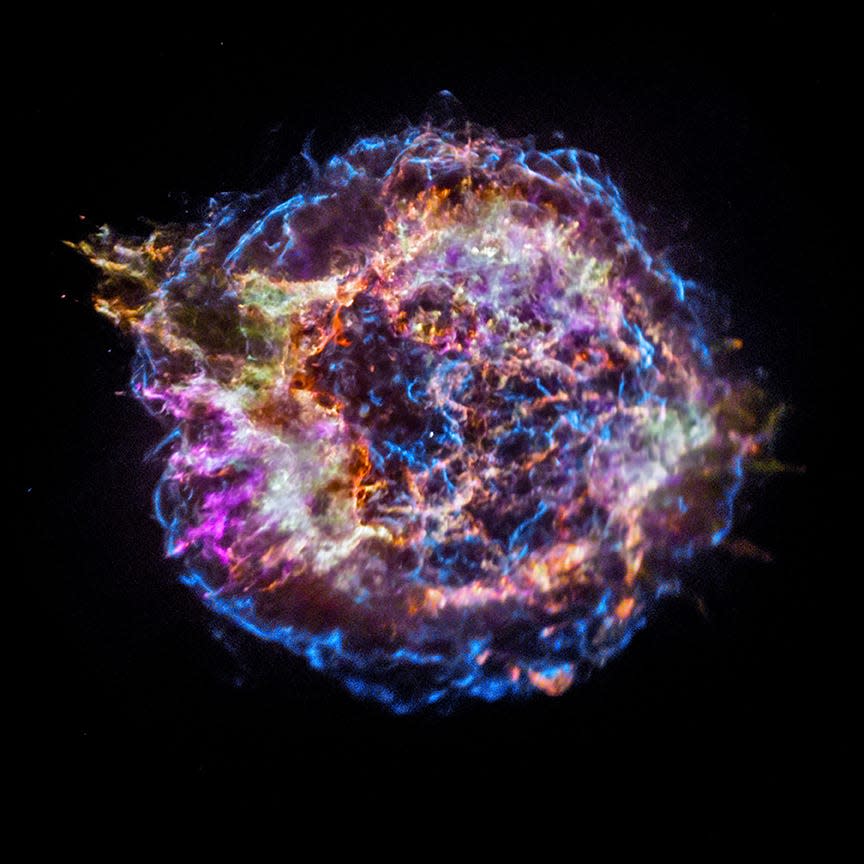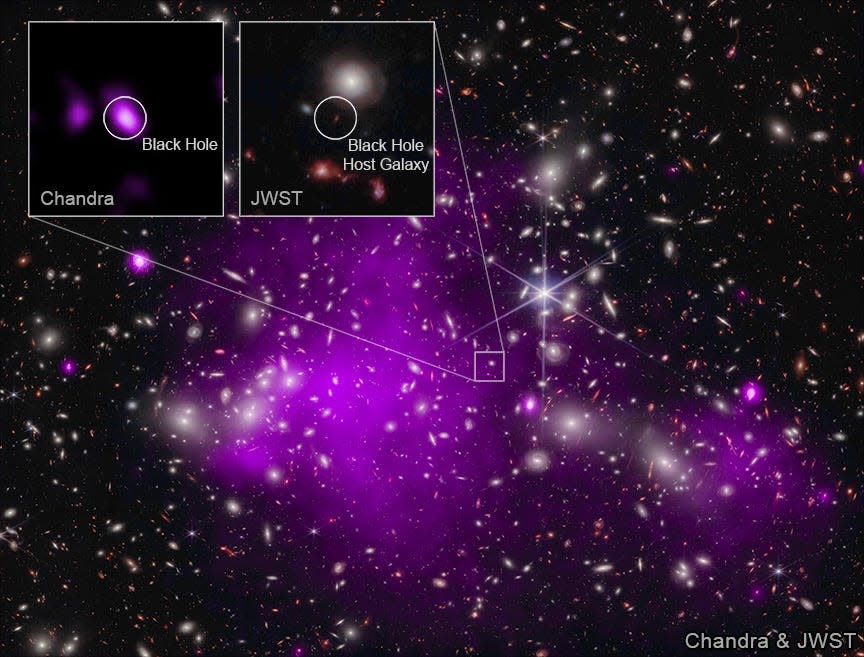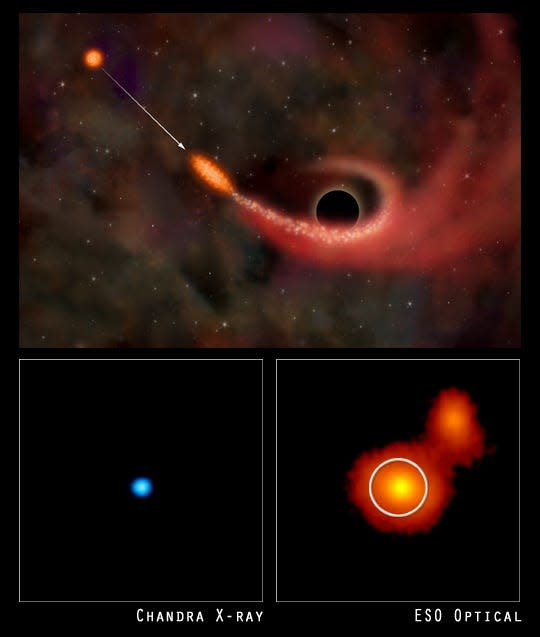A NASA telescope unlocked the mysteries of black holes. Now it's on the chopping block.
The Chandra X-ray Observatory, one of four great space telescopes NASA launched in the 1990s, revolutionized our understanding of the universe from the moment it first began recording X-rays ? the energy emitted by extremely hot objects, like the matter swirling into black holes. Now 25 years old, scientists involved with the telescope believe it can last another decade.
But the president's budget for next year sliced almost $1 billion from NASA's funding request, a roughly 12% cut. The space agency then allocated only a fraction of what's needed to keep Chandra going each year, slating $41 million for the upcoming year and $25 million for the year after. It needs about $70 million annually for normal operations. The shortfall would shut down the telescope and leave the project adrift, without enough to even wind it down properly, astronomers say.
"This is a challenging budget environment, and that means we need to make difficult decisions," Mark Clampin, director of the Astrophysics Division at NASA Headquarters, said in an email to USA TODAY. "NASA has to balance investments in future missions against some of our larger missions in extended science operations."
Of the four great telescopes NASA launched in the 90s, two have aged out. One, the Hubble, needed glasses, but has been going strong since. The agency will hold a review this spring for both the Hubble and Chandra to reduce the "cost of science operations for both observatories" before determining how to proceed, Clampin wrote.
Astronomer David Pooley, whose research depends on the Chandra, disagrees with the idea that the telescope has outlived its usefulness. He compared NASA’s logic to deciding against sending your child to college because you don't have the money for the plane ticket to get them there.
The loss of Chandra, said Pooley, a professor of physics and astronomy at Trinity University in San Antonio, "is going to be disastrous for X-ray astronomy."
Chandra has offered many insights, including how supermassive black holes can coexist in the same galaxy, that Einstein's theory of general relativity holds, so space-time is a continuum, and the first direct proof that most of the matter in the universe is "dark" – unable to be seen but still exerting a gravitational pull on galaxies and gas.
X-ray astronomy uses the same kind of light to explore the cosmos that doctors use to look inside the body.
"The X-ray sky is incredibly dynamic," Pooley said. Unlike the sky we see, which looks the same night after night, "the X-ray sky is just violent and variable and exciting."
That means it's not predictable, he said.

He said one of the great things about Chandra is that it's been able to redirect toward exciting events as they appear, like an outburst from a black hole binary star system, enabling scientists to see the dynamism in action and unravel what's going on.
"So much of the science depends on being able to look at a source when it's doing something interesting," Pooley said, noting that reducing the budget even the first year will eliminate the flexibility to do that.
The next X-ray telescope won't be ready to launch until 2032, according to NASA's current timetable. And if there's a gap until then, there won't be anyone still around with expertise in X-ray astronomy, Pooley said.
If the mission is cut now, about 50 astronomers will lose their jobs this year, but even more importantly, students will stop training in the field of X-ray astronomy because they know they won't have a telescope to use for at least a decade.
"This is the existential crisis we face," Pooley said. To have a vibrant field of X-ray astronomy requires both a mission and astronomers, he said, and with these budget cuts, "there are just simply not going to be people who can do this."
Space aging
When NASA designs missions, it considers anything that lasts longer than five years a success.
The first of its four Great Observatories was Hubble, launched in 1990, which can perceive in the ultraviolet, visible, and near-infrared regions of the spectrum of electromagnetic energy waves. Astronomers rapidly realized that its primary mirror had been polished to the wrong shape. Luckily, its orbit was close enough to the Earth that it could be serviced by astronauts on the Space Shuttle and in 1993 they added an external corrective device to clear up its vision.
Second was the Compton Gamma-Ray Observatory, focused on the gamma and X-ray areas of the spectrum, which lasted from 1991 to 1999. The Spitzer Space Telescope launched in 2003 and was dedicated to infrared astronomy. It was deactivated in 2020 after it ran out of coolant and eventually lost the ability to communicate with Earth.
The Chandra was launched aboard the Space Shuttle Columbia on July 23, 1999 – it will turn 25 this summer.
As NASA's Clampin noted, "Chandra was originally designed for a mission of five years and has now been operating for nearly 25 years."

"Space is a harsh environment that eventually limits mission lifetimes," he said. A review in 2022 recommended keeping it going through 2025 but noted doing so was becoming more complex as it aged, given the difficulties of managing in the temperatures of space.
Hubble, likely because of its early problems, has its own line item in the federal budget, apart from NASA's and is apparently not targeted with budget cuts at this time.
Chandra's staff cannot speak publicly about the telescope. As federal employees, any comments they make could be considered lobbying, which would be illegal.
Last month more than 700 astronomers worldwide, including nobel laureate Rainer Weiss, signed a letter defending the telescope and Pooley said the field continues to need what it has to offer. They hope their lobbying and public support will encourage Congress to restore funding.
"I strongly disagree with the idea that Chandra is old news," Pooley said. "It is our flagship and it is cutting edge still."
Collaborative research
NASA's new James Webb Space Telescope, deployed in early 2022, was designed to work in concert with the Chandra. Space telescopes from the U.S. and other countries work together to create a combined picture of the universe.
Together, the Webb and Chandra have located extremely distant, massive black holes, Pooley said, which is "a fundamentally exciting result that has a lot of astronomers scratching our heads and realizing that we have a lot of work to do to understand our early universe."

In his own research, Pooley said, he uses optical telescopes from the ground and space in collaboration with the Chandra to understand quasars – extremely bright, supermassive black holes in the distant universe ? and dark matter, whose presence is determined by its gravity rather than the light it emits.
"If we can understand dark matter distribution, that can help inform ideas about what it is made of," he said.
"It's all this amazing information and it's absolutely reliant on something as powerful as Chandra, with that kind of resolution," Pooley said. "This is impossible to do any other way."
NASA's Clampin said other current and planned telescopes will compensate for the loss of Chandra.
But researchers at the Massachusetts Institute of Technology, some of whom have been involved in Chandra and others who have not, wrote a joint statement saying it will be decades before another telescope has the resolution and X-ray capability of Chandra.
“A versatile, general-purpose observatory like Chandra, that complements other instruments with capabilities that no other X-ray telescope can match, will continue to make important discoveries," said research scientist Hans Moritz Guenther.
“The astronomical community certainly hasn’t run out of ideas for using (Chandra)," added research scientist Catherine Grant.
What Chandra has shown so far
Before Chandra was turned on, astronomers knew there was a background "hum" of X-rays in the universe, but they didn't know why. From its first images sent back from outer orbit 25 years ago, they were able to see that the rays were coming from specific spots in the sky, identified as black holes.
"Dark matter tends to pull the Universe together, and dark energy tends to drive it apart. Chandra’s immense power has enabled critical observational breakthroughs to advance our theoretical understanding of this cosmic struggle," according to a website set up in the telescope's defense, SaveChandra.org.

It was Chandra that confirmed when the first gravitational waves were captured by the Laser Interferometer Gravitational-Wave Observatory or LIGO, an event that led to a Nobel prize and confirmed Einstein's theories once and for all.
That 2017 event marked the first time astronomers had all of the necessary pieces of information to confirm predictions about the merging of neutron stars and the production of gravitational waves followed by signals in gamma rays, X-rays, optical and infrared light.
"This is a big deal because it's an entirely new level of knowledge," astronomer Daryl Haggard said at the time. "This discovery allows us to link this gravitational wave source up to all the rest of astrophysics, stars, galaxies, explosions, growing massive black holes, and of course neutron star mergers."
Decades ago, astronomer Carl Sagan captured the public's imagination by describing the universe – including Earth and its inhabitants – as being made of stardust.
With Chandra, Pooley said, he can show his undergraduates the chemical elements essential for life as they are literally blown out of exploding stars and spread across space and time.
"The students are just sitting there with their mouths open," he said. "This isn't just some abstract idea. They see it happening in front of their eyes."
Karen Weintraub can be reached at [email protected].
This article originally appeared on USA TODAY: NASA's Chandra X-ray Observatory slated for budget cuts after 25 years
